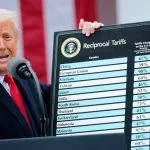
(WASHINGTON) — President Donald Trump on Monday will sign an executive order delaying steep levies on dozens of countries that were set to take effect on Wednesday, the White House said.
Trump’s so-called reciprocal tariffs will now take effect on Aug. 1, White House press secretary Karoline Leavitt told reporters.
Minutes earlier, Trump announced 25% tariffs on South Korea and Japan that would take effect at the start of August. Twelve additional countries would receive notifications Monday about new tariffs, Leavitt said.
Trump delayed the “reciprocal tariffs” in April, vowing to strike roughly 90 trade deals in 90 days. So far, the White House says it has reached trade agreements with only the United Kingdom and Vietnam, as well as a preliminary accord with China.
“The president and his trade team want to cut the best deals for the American people and the American worker,” Leavitt said.
The return of the policy would dramatically hike tariffs on dozens of trade partners. Examples include a 49% tariff on Cambodia and a 37% tariff on Bangladesh.
Here’s what to know about Trump’s tariff deadline and what it means for you:
What was Trump’s July 9 tariff deadline?
The deadline on Wednesday traced back to the Rose Garden “Liberation Day” tariff announcement on April 2, when Trump imposed country-specific levies on most U.S. trading partners as part of a wider policy rollout.
The major stock indexes lost about $3.1 trillion in value the next day, suffering their biggest one-day decline since the onset of the COVID-19 pandemic. Days later, Trump imposed a 90-day suspension of the country-specific tariffs, sending the market to one of its largest ever single-day increases.
Since then, the stock market has climbed to a record high and key measures of economic performance have proven resilient.
On Wednesday, the 90-day suspension was set to expire. The vast majority of nations targeted by the tariffs had yet to strike a trade agreement with the U.S., meaning the deadline could have brought back the slate of tariffs that had triggered the April stock selloff.
Is the Trump administration pushing back its tariff deadline?
The White House on Monday said it plans to push back the July 9 deadline.
The announcement came after U.S. Treasury Secretary Scott Bessent on Sunday said the Trump administration planned to send letters to about 100 countries, warning that high tariffs could return at the start of next month.
The letters, Bessent told CNN, will tell target countries “if you don’t move things along, then on August 1st, you will boomerang back to your April 2nd tariff level.”
Trump appeared to echo the plans in a social media post on Sunday, saying the White House would soon send out “UNITED STATES TARIFF Letters.”
In a separate social media post on Monday, Trump threatened to place an additional 10% tariff on countries that align with BRICS nations, suggesting he had not backed off his commitment to levies.
BRICS nations, which recently voiced “serious concerns” about unilateral tariffs, are made up of founding members Brazil, Russia, India and China, among a few others.
Where do Trump’s tariffs stand now?
In recent weeks, Trump has dialed back some of his steepest tariffs. Another batch of tariffs remains in legal limbo following a pair of federal court rulings in May, though the levies remain in place for now.
A trade agreement last month between the U.S. and China slashed tit-for-tat tariffs between the world’s two largest economies.
Still, an across-the-board 10% tariff applies to nearly all imports, except for semiconductors, pharmaceuticals and some other items.
Goods from Mexico and Canada face tariffs of 25%, though the measure excludes products covered under the United States-Mexico-Canada Agreement, or USMCA. In May, Trump vowed to double steel and aluminum tariffs. Tariffs still apply to autos and car parts.
Jim Reid, a research strategist at Deutsche Bank, said in a memo to clients on Monday that the firm’s economists estimate a current effective tariff rate of 15%.
The level of tariffs has fallen “a good deal below the implied rate from Liberation Day,” but it remains “well above the low single figures before Trump returned to office,” Reid added.
Citing the pullback of other tariffs, Reid voiced skepticism about sturdiness of the Aug. 1 deadline.
Aug. 1, Reid said, “might be the new July 9.”
Copyright © 2025, ABC Audio. All rights reserved.
